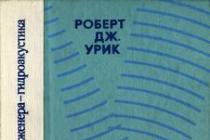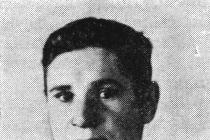Introduction
In this essay, I examined not only ship hydroacoustic equipment, but also the very concept of hydroacoustics in general. As well as its development, especially during the Soviet period. I disassembled the structure of hydroacoustic systems and their classification. For each class of hydroacoustic equipment, I gave the name of foreign samples and companies producing them, which can be found on the modern market.
Hydroacoustics as a science
Hydroacoustics- a branch of acoustics that studies the radiation, reception and propagation of sound waves in a real aquatic environment (ocean, seas, lakes, etc.) for the purposes of underwater location, communications, etc.
This is the science of underwater sound, its emission, propagation, absorption, scattering, reflection, reception, and a branch of technology based on the achievements of this science.
Hydroacoustics has received wide practical application, because no types of electromagnetic waves propagate in water (due to its electrical conductivity) over any significant distance, and sound is therefore the only possible means of communication under water.
For these purposes, sound frequencies from 300 to 10,000 Hz and ultrasound from 10,000 Hz and above are used. Electrodynamic and piezoelectric emitters and hydrophones are used as emitters and receivers in the sound domain, and piezoelectric and magnetostrictive ones in the ultrasonic domain. In addition to underwater sound communication, hydroacoustics is used for:
· Detecting noise signals and determining the direction to them;
· Emission of acoustic signals, detection of reflected signals and determination of coordinates;
· Classification of detected signals
The most significant applications of hydroacoustics:
· To solve military problems;
· Marine navigation;
· Sound-underwater communication;
· Fishing exploration;
· Oceanological research;
· Areas of activity for the development of the resources of the bottom of the World Ocean;
· Using acoustics in the pool (at home or in a synchronized swimming training center)
· Training of sea animals.
Development of hydroacoustics
Hydroacoustics as a science has a long history. Leonardo da Vinci can rightfully be considered the pioneer of this science, who at the end of the 15th century wrote in his diaries: “... if you stop the ship, take a long hollow tube and lower one end into the water, and put the other end to your ear, you will hear ships, located at a great distance..." Among the scientists who left their mark on acoustics were Newton, d'Alembert, Lagrange, Bernoulli, Euler, Rayleigh and many others.
Hydroacoustics as an engineering discipline received its development at the beginning of the twentieth century, when 1912 R. Fessenden (USA) developed the first high-power hydroacoustic emitter. Around the same time, the Russian engineer R. N. Nirenberg created the first underwater telegraph station, and at the end of the 20s, V. N. Tyulin created the first hydroacoustic station (echo sounder).
Let us immediately make a reservation that many research and production enterprises located throughout the former Soviet Union contributed to the formation and development of domestic hydroacoustics. Covering the issues of creating hydroacoustic systems, one cannot fail to mention the significant role of the Central Research Institute named after. acad. A. N. Krylov, Acoustic Institute named after. acad. N. N. Andreeva, Central Research Institute "Gidropribor", NPO "Atoll" (Dubna), Central Research Institute "Rif" (Balti), NPO "Slavutich" (Kiev), a number of institutes of the Academy of Sciences - Institute of Applied Physics RAS, Pacific Oceanological Institute, Institute of Oceanology named after. P. P. Shirshov, and many others. A significant role in the design of hydroacoustic equipment has always been taken by the Central Design Bureau - the designers of the carrier ships of the SAC: TsKB MT "Rubin", SPMBM "Malachite", etc. The most important role in training personnel for the industry was played by educational institutions involved in the training of acoustic specialists - the Leningrad Electrotechnical Institute ( now St. Petersburg State Technical University "LETI"), Leningrad Shipbuilding Institute (now St. Petersburg State Medical University), Moscow State University. M.V. Lomonosov, Far Eastern Polytechnic Institute, Taganrog Radio Engineering Institute (now TRTU) and some other universities in the country. It is impossible not to mention a number of military research organizations that actively participated in the formation of technical specifications for hydroacoustic systems and complexes, and were directly involved in testing and delivery of finished products to the fleet. In recent years, the Kamchatka Hydrophysical Institute, ZAO Aquamarine, Central Research Institute Elektropribor, and others have been actively involved in the creation of hydroacoustic means.
In this context, it seems appropriate to briefly touch upon the stage of origin and development of domestic hydroacoustics, once again emphasizing the decisive role played in this process by Leningrad - St. Petersburg.
In the first third of the twentieth century, which can be considered as a period of initial accumulation of information and the search for technologies necessary for the design of hydroacoustic systems, a decisive role was played by such industrial organizations and universities of the city as the Baltic Plant, Ostekhburo, Central Radio Laboratory (TsRL), Plant named after. Comintern, State Electrotechnical Institute, Institute of Radio Reception and Acoustics (IRPA), Physics and Technology Laboratory, LETI im. V.I. Ulyanova (Lenin) and others. They worked in close cooperation with the Hydrographic Directorate of the Fleet, the Naval Academy, the Scientific Research Maritime Communications Institute (NIMIS), the Scientific Research Site of Communications, the School of Communications, etc. In these institutions such prominent scientists as academicians N.N. Andreev, A.I. Berg, A.F. Ioffe, L.I. Mandelstam, V.F. Mitkevich, doctors of sciences L.Ya. Gutin, B.A. Kudrevich, I. N. Meltreger, S. Ya. Sokolov, V. N. Tyulin, E. E. Shvede, engineers P. P. Kuzmin, R. G. Nirenberg, A. I. Pustovalov, N. I. Sigachev etc. The results of the activities of these scientists and engineers give reason to consider Leningrad the birthplace of domestic hydroacoustics, and such scientists as N. N. Andreev, L. Ya. Gutin, S. Ya. Sokolov and V. N. Tyulin should rightfully be attributed to its founders.
For the thirties of the twentieth century, the creation of the Vodtranspribor plant in Leningrad in 1932, the first serial plant in the field of hydroacoustic instrument making, was certainly a milestone for the development of domestic hydroacoustics. One of the important tasks that the plant successfully solved was the liberation of the country from foreign dependence in the field of sonar technology. A high assessment of the plant’s activities was the award in 1941 to a group of its specialists E. I. Aladyshkin, A. S. Vasilevsky, V. S. Kudryavtsev, M. I. Markus, L. F. Sychev, Z. N. Umikov, and also to NIMIS employee P.P. Kuzmin the Stalin Prize for the creation of the first domestic sonar "Tamir-1". Created by the plant by 1941. hydroacoustic equipment, their continuous production during the Great Patriotic War, as well as a well-organized system of designer supervision over the operation of equipment on ships allowed the Navy to successfully solve combat missions during the war. The creative life of hydroacoustics specialists did not stop even during the evacuation of the plant to Omsk. Indicative is the fact that in 1943 a group of specialists from the plant, the Mine Torpedo Institute and a number of other organizations created the “Crab” proximity acoustic fuse for the large KB-3 anchor mine. In 1949, the creators of the fuse were awarded the Stalin Prize.
A landmark event in the first post-war years was the creation of a special design bureau (OKB-206) at the Vodtranspribor plant. The creation of the OKB was determined by a decree of the USSR Government of July 10, 1946, which approved a 10-year program for the development of hydroacoustic equipment with significantly increased performance characteristics for the Navy in support of the adopted military shipbuilding program. Thus, the prerequisites were created for the formation in 1949, on the basis of OKB-206, of the country's first research institute for sonar and hydroacoustics - NII-3 of the Ministry of Shipbuilding Industry. Highly qualified specialists moved from the Design Bureau to the institute, who formed the backbone of the institute and made a great contribution to the development of hydroacoustics.
In the mid-70s, the Morfizpribor Central Research Institute was tasked with creating hydroacoustic weapons for deep-sea underwater vehicles, small and ultra-small submarines (MPL and SMPL). The displacement of such vessels ranges from several tens to two to three hundred tons, which imposes very strict restrictions on the weight and size parameters of hydroacoustic equipment. At the same time, this equipment must be multifunctional and solve the problems of noise direction finding, echolocation, detection of hydroacoustic signals, hydroacoustic communications, driving divers, controlling transponder beacons, etc. At the same time, the tasks of detecting targets and signals must be solved throughout the entire water space, including the upper hemisphere . The number of ship personnel reduced to a minimum necessitated a high level of automation of hydroacoustic control processes. Finally, it was necessary to ensure reliable operation of hydroacoustic antennas at high hydrostatic pressure. All these scientific, technical and technological problems have been overcome. As a result, a number of sonar systems were adopted by the Navy. Among them is the multifunctional SJSC "Pripyat-P" for the small submarine "Piranha".
Today, hydroacoustics plays the role of “eyes” and “ears” during various underwater work and research. Despite the recent active development of radio and telecommunications, their use in underwater space is greatly limited due to the physical laws of propagation of electric and radio waves in water. The use of various video cameras and video devices is limited by conditions of poor visibility (usually at a depth of 100 meters, the visual observation zone does not exceed 10 meters). The use of hydroacoustic instruments makes it possible to obtain data on underwater objects at almost all depths of the World Ocean, and the latest developments make it possible to obtain images of underwater space with a resolution of several centimeters.
Hydroacoustics (from hydro... And acoustics ), a branch of acoustics that studies the propagation of sound waves in a real aquatic environment (oceans, seas, lakes, etc.) for the purposes of underwater location, communications, etc. An essential feature of underwater sounds is their low attenuation, as a result of which sounds under water can travel over much greater distances than, for example, in the air.
So, in the area of audible sounds for the frequency range 500--2000 Hz the range of propagation of medium-intensity sounds under water reaches 15-20 km, and in the field of ultrasound - 3--5 km. Based on the sound attenuation values observed in laboratory conditions in small volumes of water, one would expect significantly greater ranges. However, under natural conditions, in addition to attenuation caused by the properties of water itself (the so-called viscous attenuation), refraction sound and its scattering and absorption by various inhomogeneities of the medium.
Refraction of sound, or curvature of the path of a sound beam, is caused by heterogeneity in the properties of water, mainly vertically, due to three main reasons: changes in hydrostatic pressure with depth, changes in salinity and changes in temperature due to unequal heating of the water mass by the sun's rays. As a result of the combined effect of these reasons, the speed of sound propagation is about 1450 m/sec for fresh water and about 1500 m/sec for marine water, it changes with depth, and the law of change depends on the time of year, time of day, depth of the reservoir and a number of other reasons.
Sound rays emerging from the source at a certain angle to the horizon are bent, and the direction of the bend depends on the distribution of sound speeds in the medium.
In summer, when the upper layers are warmer than the lower ones, the rays bend downwards and are mostly reflected from the bottom, losing a significant share of their energy. On the contrary, in winter, when the lower layers of water maintain their temperature, while the upper layers cool, the rays bend upward and undergo multiple reflections from the surface of the water, during which much less energy is lost. Therefore, in winter the range of sound propagation is greater than in summer. Due to refraction, so-called dead zones (shadow zones), i.e. areas located close to the source in which there is no audibility.
The presence of refraction, however, can lead to an increase in the range of sound propagation - the phenomenon of ultra-long propagation of sounds under water. At some depth below the surface of the water there is a layer in which sound travels at the lowest speed; Above this depth, the speed of sound increases due to an increase in temperature, and below this depth due to an increase in hydrostatic pressure with depth. This layer is a kind of underwater sound channel. A beam that has deviated from the channel axis up or down, due to refraction, always tends to get back into it (Fig. 1.2).
Rice. 1.2. Propagation of sound in an underwater sound channel: a - change in the speed of sound with depth; b - ray path in the sound channel.
If you place the source and receiver of sound in this layer, then even sounds of medium intensity (for example, explosions of small charges of 1--2 kg) can be recorded over distances of hundreds and thousands km. A significant increase in the range of sound propagation in the presence of an underwater sound channel can be observed when the sound source and receiver are located not necessarily near the channel axis, but, for example, near the surface. In this case, the rays, refracting downward, enter deep-sea layers, where they are deflected upward and exit again to the surface at a distance of several tens km from the source.
Next, the pattern of ray propagation is repeated and as a result a sequence of so-called rays is formed. secondary illuminated zones, which are usually traceable to distances of several hundred km. The phenomenon of ultra-long-range sound propagation in the sea was discovered independently by American scientists M. Ewing and J. Worzel (1944) and Soviet scientists L. M. Brekhovskikh and L. D. Rosenberg (1946).
The propagation of high-frequency sounds, in particular ultrasounds, when the wavelengths are very small, is influenced by small inhomogeneities usually found in natural bodies of water: microorganisms, gas bubbles, etc. These inhomogeneities act in two ways: they absorb and scatter the energy of sound waves. As a result, as the frequency of sound vibrations increases, the range of their propagation decreases. This effect is especially noticeable in the surface layer of water, where there are most inhomogeneities.
The scattering of sound by inhomogeneities, as well as uneven surfaces of the water and bottom, causes the phenomenon of underwater reverberation , accompanying the sending of a sound impulse: sound waves, reflecting from a set of inhomogeneities and merging, give a prolongation of the sound impulse, which continues after its end, similar to the reverberation observed in enclosed spaces. Underwater reverberation is a fairly significant interference for a number of practical applications of hydroacoustics, in particular for sonar .
The range of propagation of underwater sounds is also limited by the so-called. the sea's own noises, which have a dual origin. Some of the noise comes from the impact of waves on the surface of the water, from the sea surf, from the noise of rolling pebbles, etc. The other part is related to marine fauna; This includes sounds made by fish and other marine animals.
Hydroacoustics has received wide practical application, because no types of electromagnetic waves, including light, propagate in water (due to its electrical conductivity) over any significant distance, and sound is therefore the only possible means of communication under water. For these purposes, they use sound frequencies from 300 to 10,000 Hz, and ultrasound from 10,000 Hz and higher.
Key words: hydroacoustics, refraction, sound channel, ultra-long-range spreading sound, reverberation, sonar.
Control questions
- 1. How is engaged hydroacoustics?
- 2. Explain phenomenon refraction sound V water.
- 3. IN how is phenomenon ultra-long-range distribution sound?
- 4. How called underwater reverberation?
03
Aug
2017
Library of hydroacoustics engineer. Fundamentals of hydroacoustics (Urik R.J.)
 Series: Hydroacoustics Engineer Library
Series: Hydroacoustics Engineer Library
Format: DjVu, Scanned pages + recognized text layer
Urick R.J.
Year of manufacture: 1978
Genre: engineering
Publisher: Shipbuilding
Russian language
Number of pages: 448
Description: The book by Robert J. Urick, one of the leading US specialists in the field of hydroacoustics, covers issues related to the propagation of hydroacoustic signals in deep and shallow seas, the reflection and dispersion of these signals in the environment and from its boundaries, the sources and characteristics of noise and interference. Recommendations are given for calculating the parameters of various hydroacoustic equipment.
One of the advantages of the book is the successful combination of strict scientific character with the popularity of presentation; the mathematical apparatus is reduced to the necessary minimum.
The book is intended for specialists in the field of hydroacoustics, students of higher and secondary educational institutions of relevant specialties, and may also be of interest to a wide range of readers interested in issues of hydroacoustics and sonar.
13
Jul
2017
Library of hydroacoustics engineer. Handbook on hydroacoustics (Evtyutov A.P., Kolesnikov A.E., Lyalikov A.P., etc.)

Author: Evtyutov A.P., Kolesnikov A.E., Lyalikov A.P. and etc.
Year of manufacture: 1982
Genre: Reference
Publisher: Shipbuilding
Russian language
Number of pages: 344
Description: The reference book contains systematic information on hydroacoustics. Materials on the acoustic characteristics of the ocean, hydroacoustic technology, the range of hydroacoustic means, etc. are presented. The reference book offered to the attention of readers contains systematized information related to a wide range of issues of applied hydroacoustics. Oh...
14
Jun
2017
Library of hydroacoustics engineer. Acoustic underwater low-frequency emitters (Rimsky-Korsakov A.V. et al.)

Series: Hydroacoustics Engineer Library
Format: PDF/DjVu, Scanned pages + recognized text layer
Author: Rimsky-Korsakov A.V. and etc.
Year of manufacture: 1984
Genre: Hydroacoustics
Publisher: Shipbuilding
Russian language
Number of pages: 184
Description: The book presents the main types of underwater low-frequency acoustic emitters for oceanographic research and industrial use. A classification of the main types of low-frequency emitters is given, the principles of their operation, basic technical characteristics, design features, as well as energy supply issues are considered...
17
Jun
2017
Library of hydroacoustics engineer. Hydroacoustic equipment of the fishing fleet (Orlov L.V., Shabrov A.A.)

Series: Hydroacoustics Engineer Library
Format: DjVu, Scanned pages + recognized text layer
Author: Orlov L.V., Shabrov A.A.
Year of manufacture: 1987
Genre: Mechanical Engineering
Publisher: Shipbuilding
Russian language
Number of pages: 222
Description: Describes the organization of product development. The problems of engineering calculation of antennas of search stations of echo sounders and Doppler logs are considered. Information is provided on the directivity of antennas and hydrophones with impedance screens of finite sizes, refined expressions and graphs for calculating piezoelectric transducers. Describes methods for determining...
02
Jul
2017
Library of hydroacoustics engineer. Radiation and scattering of sound (Shenderov E.L.)

ISBN: 5-7355-0101-1
Series: Hydroacoustics Engineer Library
Format: DjVu, Scanned pages
Author: Shenderov E.L.
Year of manufacture: 1989
Genre: Physics
Publisher: Shipbuilding
Russian language
Number of pages: 304
Description: The main issues related to the radiation and scattering of sound waves in hydroacoustics are outlined. Methods for calculating sound fields for hydroacoustic emitters of complex shape and methods for determining the characteristics of sound fields scattered by obstacles are considered. For engineers involved in the design of ship hydroacoustic instruments, specialists in shipbuilding and architecture...
09
Sep
2016
Hyperboloid of Engineer Garin (Alexey Tolstoy)

Format: audio play, AAC, 192 kbps
Author: Alexey Tolstoy
Year of manufacture: 2016
Genre: fantasy, novel
Publisher: Radio Russia
Performer: Sergey Chonishvili, Madeleine Dzhabrailova, Alexey Kolubkov, Igor Gordin, Andrey Danilyuk
Duration: 04:02:01
Description: At the beginning of May 192... in Leningrad, a murder occurs at an abandoned dacha on the Krestovka River. Criminal investigation officer Vasily Vitalievich Shelga discovers a stabbed man with signs of torture. Some physical and chemical experiments were carried out in the spacious basement of the dacha. It is suggested that the murdered man is a certain engineer...
28
Oct
2012
Hyperboloid of engineer Garin (Alexey Tolstoy)

Format: audiobook, MP3, 192kbps
Author: Alexey Tolstoy
Year of manufacture: 2011
Genre fiction
Publisher: Balance
Performer: Sergey Efremov
Duration: 13:09:17
Description: The novel “The Hyperboloid of Engineer Garin” (1927), one of the writer’s few science fiction works, was revised several times by him in 1934, 1936 and 1939. The extraordinary adventures of the Russian scientist and adventurer Pyotr Garin take place against the backdrop of revolutionary events in Russia and in the world, causing changes both on geographical maps and in the minds of people. Obsessed with the idea of world domination, the main character at the same time...
09
Mar
2013
Hyperboloid of engineer Garin (Alexey Tolstoy)

Format: audio play, MP3, 160kbps
Author: Alexey Tolstoy
Year of manufacture: 2008
Genre: Fantasy, adventure
Publisher: Radio Russia
Performer: Sergey Chonishvili, Madeleine Dzhabrailova, Alexey Kolubkov, Igor Gordin, Andrey Danilyuk, Irina Kireeva, Gleb Podgorodinsky, Dmitry Pisarenko, Alexander Ponomarev
Duration: 04:02:02
Description: At the beginning of May 192... in Leningrad, a murder occurs at an abandoned dacha on the Krestovka River. Criminal investigation officer Vasily Vitalievich Shelga discovers a stabbed man with signs of torture. In the spacious basement of the dacha some events were held...
16
Apr
2013
Handbook of Circuit Engineer (R. Koris, H. Schmidt-Walter)

ISBN: 978-5-94836-164-2
Format: DjVu, OCR without errors
Author: R.Coris, H.Schmidt-Walter
Year of manufacture: 2008
Genre: Technical literature
Publisher: Tekhnosphere
Russian language
Number of pages: 608
Description: A convenient, compact and fairly complete source of information on electrical engineering and electronics, the basics of calculating DC and AC circuits, the laws of electric and magnetic fields, the principles of measuring basic electrical quantities, analog and digital circuitry, and power electrical components. A large number of illustrations make it easy to find the necessary information. Books...
08
Feb
2014
Hyperboloid of engineer Garin (Alexey Tolstoy)

Author: Tolstoy Alexey
Year of manufacture: 2014
Genre fiction
Publisher: Can't buy it anywhere
Performer: Prudovsky Ilya
Duration: 14:59:44
Description: Alexey Nikolaevich Tolstoy (1883–1945) is an outstanding Russian Soviet writer, poet and playwright, a classic of Russian literature, the author of many diverse works: from the epic “Walking through the Torment” to the children's fairy tale “The Golden Key, or the Adventures of Pinocchio.” The novel “Engineer Garin’s Hyperboloid” (1927), one of the writer’s few science fiction works, was revised several times by him in 1934, 1936...
10
Sep
2012
Hyperboloid of engineer Garin (Alexey Tolstoy)

Format: audiobook, MP3, 128kbps
Author: Alexey Tolstoy
Year of manufacture: 2009
Genre: Science fiction
Publisher: Vira-M
Performer: Dmitry Savin
Duration: 12:14:23
Description: The famous novel by Alexei Nikolaevich Tolstoy has rightfully entered the golden fund of Russian science fiction. A talented, but vain and selfish engineer Pyotr Garin invented a unique device capable of burning ships with a heat ray, destroying factories, and burning the earth. With its help, the inventor hopes to take possession of countless reserves of gold in the depths of the earth and become the dictator of the whole world. And he almost succeeds...
19
Jul
2011
Hyperboloid of engineer Garin (Alexey Tolstoy)

Format: audiobook, MP3, 160kbps
Author: Alexey Nikolaevich Tolstoy
Year of manufacture: 2005
Genre fiction
Publisher: SiDiKom
Performer: Kirill Petrov
Duration: 10:51:40
Description: This warning novel, written at the dawn of Russian science fiction, gives us pictures of how a dictatorship is born and what kind of ending awaits it. Garin, a talented engineer in whom “genius and villainy” turn out to be easily compatible, creates a weapon that, according to his plan, will help him take over the world. But whoever has everything has nothing. A hyperboloid can burn ships, blow up factories, burn through the earth...
08
Jun
2015
Hyperboloid of engineer Garin (Alexey Tolstoy)

Format: Radio play, MP3, 192kbps
Author: Alexey Tolstoy
Year of manufacture: 2008
Genre: Russian classical dramatized fiction
Publisher: Radio Russia
Performers: Sergey Chonishvili, Madeleine Dzhabrailova, Alexey Kolubkov, Igor Gordin, Andrey Danilyuk, Irina Kireeva, Gleb Podgorodinsky, Dmitry Pisarenko, Alexander Ponomarev
Duration: 04:02:02
Description: At the beginning of May 192... in Leningrad, a murder occurs at an abandoned dacha on the Krestovka River. Criminal investigation officer Vasily Vitalievich Shelga discovers a stabbed man with signs of torture. In the spacious basement of the dacha...
14
Jun
2008

Year of manufacture: 2008
Version: April 2008
Developer: Forum Media Publishing House LLC Compatible with Vista: yes
System requirements: Windows 2000/XP
Interface language: Russian only
Tablet: Present
Description: Contents 1. Legal basis for labor protection 1.1. Basic provisions of Russian legislation on occupational safety (short list) 1.2. Basic by-laws and other normative acts (list of basic documents) 1.3. Responsibilities of the employer to ensure safe conditions and occupational safety 1.4. State authorities OT 1.5. Supervisory and control bodies 1.6. Responsibility for violation is required...
20
Apr
2010
Fundamentals of Ayurveda (Sergey Serebryakov) [Esoterics, MP3]

Author: Sergey Serebryakov
Genre: audio lectures on Vedic culture
Publisher: Open Vedic University
Performer: Sergey Serebryakov (Kishora Kishori Das)
Duration: 10:48:00
Description: Serebryakov Sergey Vladimirovich was born in St. Petersburg in 1971. Specialist in the field of family and child psychology, palmistry. Since 1991, he has been studying Vedic sciences and has received official initiation from a representative of the chain of disciplic succession of Vedic wisdom. Received higher education at the Bhaktivedanta Institute (Bombay, India), specializing in Ayurveda. Today it is...
20
Jul
2008
Fundamentals of Optoelectronics

ISBN: 5-03-001207-9
Format: DjVu, Scanned pages
Year of manufacture: 1988
Author: Y. Suematsu, S. Kataoka, K. Kishino, Y. Kokubun, T. Suzuki, O. Ishii, S. Yonezawa.
Genre: educational literature
Publisher: Mir, Moscow
Number of pages: 288
Description: The book is a translation of the second volume of an 11-volume series on microelectronics, written by prominent Japanese specialists. Dedicated to modern methods of development, manufacturing and application of optoelectronic elements, computer memory devices, as well as visual information display devices. The physical principles of operation of these devices, their comp...
Hydroacoustics (from Greek hydor- water, acousticoc- auditory) - the science of phenomena occurring in the aquatic environment and associated with the propagation, emission and reception of acoustic waves. It includes issues of development and creation of hydroacoustic devices intended for use in the aquatic environment.
History of development
Basics of hydroacoustics
Features of the propagation of acoustic waves in water

Components of an echo event.
Comprehensive and fundamental research on the propagation of acoustic waves in water began during the Second World War, which was dictated by the need to solve practical problems of navies and, first of all, submarines. Experimental and theoretical work was continued in the post-war years and summarized in a number of monographs. As a result of these works, some features of the propagation of acoustic waves in water were identified and clarified: absorption, attenuation, reflection and refraction.
The absorption of acoustic wave energy in sea water is caused by two processes: internal friction of the medium and dissociation of salts dissolved in it. The first process converts the energy of an acoustic wave into heat, and the second, transforming into chemical energy, removes molecules from an equilibrium state, and they disintegrate into ions. This type of absorption increases sharply with increasing frequency of acoustic vibration. The presence of suspended particles, microorganisms and temperature anomalies in water also leads to attenuation of the acoustic wave in water. As a rule, these losses are small and are included in the total absorption, but sometimes, as, for example, in the case of scattering from the wake of a ship, these losses can amount to up to 90%. The presence of temperature anomalies leads to the fact that the acoustic wave falls into acoustic shadow zones, where it can undergo multiple reflections.
The presence of interfaces between water - air and water - bottom leads to the reflection of an acoustic wave from them, and if in the first case the acoustic wave is completely reflected, then in the second case the reflection coefficient depends on the bottom material: a muddy bottom reflects poorly, sandy and rocky ones reflect well. . At shallow depths, due to multiple reflections of the acoustic wave between the bottom and the surface, an underwater sound channel appears, in which the acoustic wave can propagate over long distances. Changing the speed of sound at different depths leads to bending of sound “rays” - refraction.
Sound refraction (curvature of the sound beam path)
|
Refraction of sound in water: a - in summer; b - in winter; on the left is the change in speed with depth. The speed of sound propagation changes with depth, and changes depend on the time of year and day, the depth of the reservoir and a number of other reasons. Sound rays emerging from a source at a certain angle to the horizon are bent, and the direction of bending depends on the distribution of sound speeds in the medium: in summer, when the upper layers are warmer than the lower ones, the rays bend downwards and are mostly reflected from the bottom, losing a significant share of their energy. ; in winter, when the lower layers of water maintain their temperature, while the upper layers cool, the rays bend upward and are repeatedly reflected from the surface of the water, while significantly less energy is lost. Therefore, in winter the range of sound propagation is greater than in summer. The vertical distribution of sound speed (VSD) and the velocity gradient have a decisive influence on the propagation of sound in the marine environment. The distribution of sound speed in different areas of the World Ocean is different and changes over time. There are several typical cases of VRSD: |
Dispersion and absorption of sound by inhomogeneities of the medium.
Propagation of sound in underwater sound. channel: a - change in the speed of sound with depth; b - ray path in the sound channel. The propagation of high-frequency sounds, when the wavelengths are very small, is influenced by small inhomogeneities usually found in natural bodies of water: gas bubbles, microorganisms, etc. These inhomogeneities act in two ways: they absorb and scatter the energy of sound waves. As a result, as the frequency of sound vibrations increases, the range of their propagation decreases. This effect is especially noticeable in the surface layer of water, where there are most inhomogeneities. The dispersion of sound by inhomogeneities, as well as uneven surfaces of water and the bottom, causes the phenomenon of underwater reverberation, which accompanies the sending of a sound pulse: sound waves, reflecting from a set of inhomogeneities and merging, give rise to a prolongation of the sound pulse, which continues after its end. The limits of the propagation range of underwater sounds are also limited by the natural noise of the sea, which has a dual origin: part of the noise arises from the impacts of waves on the surface of the water, from the sea surf, from the noise of rolling pebbles, etc.; the other part is associated with marine fauna (sounds produced by hydrobionts: fish and other marine animals). Biohydroacoustics deals with this very serious aspect. |
Sound wave propagation range
The propagation range of sound waves is a complex function of the radiation frequency, which is uniquely related to the wavelength of the acoustic signal. As is known, high-frequency acoustic signals quickly attenuate due to strong absorption by the aquatic environment. Low-frequency signals, on the contrary, are capable of propagating over long distances in the aquatic environment. Thus, an acoustic signal with a frequency of 50 Hz can propagate in the ocean over distances of thousands of kilometers, while a signal with a frequency of 100 kHz, typical for side-scan sonar, has a propagation range of only 1-2 km. The approximate operating ranges of modern sonars with different acoustic signal frequencies (wavelengths) are given in the table:
Areas of use.
Hydroacoustics has received wide practical application, since an effective system for transmitting electromagnetic waves under water over any significant distance has not yet been created, and sound is therefore the only possible means of communication under water. For these purposes, sound frequencies from 300 to 10,000 Hz and ultrasound from 10,000 Hz and above are used. Electrodynamic and piezoelectric emitters and hydrophones are used as emitters and receivers in the sound domain, and piezoelectric and magnetostrictive ones in the ultrasonic domain.
The most significant applications of hydroacoustics:
- To solve military problems;
- Marine navigation;
- Sound communication;
- Fishing exploration;
- Oceanological research;
- Areas of activity for the development of the resources of the ocean floor;
- Using acoustics in the pool (at home or in a synchronized swimming training center)
- Sea animal training.
Notes
Literature and sources of information
LITERATURE:
- V.V. Shuleikin Physics of the sea. - Moscow: “Science”, 1968. - 1090 p.
- I.A. Romanian Basics of hydroacoustics. - Moscow: “Shipbuilding”, 1979 - 105 p.
- Yu.A. Koryakin Hydroacoustic systems. - St. Petersburg: “Science of St. Petersburg and the sea power of Russia”, 2002. - 416 p.
And Acoustics), a branch of acoustics that studies the propagation of acoustic waves in the natural aquatic environment, and also examines various areas and methods of their underwater applications. Sound is the only type of radiation that propagates in a liquid over any significant distance. Therefore, sound waves are the only means of transmitting and receiving information underwater for various purposes - navigation, military, underwater communications, and support of marine industries.
The possibility of using underwater sound has been known for a long time. In the 15th century, Leonardo da Vinci proposed listening to ships at sea using one end of a tube lowered into the water. By the beginning of the 20th century, an underwater bell was considered as a means of navigation in coastal waters. The development and application of hydroacoustic methods for military purposes began during the First World War. In 1916, Russian engineer K. Shilovsky, together with P. Langevin, tested the first device for acoustic echolocation of underwater objects. Langevin developed a piezoelectric quartz transducer for this purpose. In 1918, the possibility of detecting submarines using hydroacoustic signals was demonstrated. Anti-submarine sonar devices were widely used during the 2nd World War. In the 20th century, the areas of application of hydroacoustics methods expanded significantly due to the development of naval and navigation technology, as well as the increasing industrial development of the World Ocean.
The main scientific task of hydroacoustics is to study the characteristics of the propagation of acoustic waves in real water environments (oceans, seas, lakes, etc.), which brings it closer to ocean acoustics. The propagation range of underwater sounds is determined by the absorption of sound in the medium and additional attenuation of sound caused by scattering on inhomogeneities of the water column, rough surfaces, bottom irregularities and absorption in bottom sediments. Refraction of sound, caused by a spatial change in the speed of sound, can, on the one hand, lead to the formation of refractive zones of the sound shadow (zones of silence), on the other hand, to the phenomenon of ultra-long-range propagation of sound in the ocean due to the formation of an underwater sound channel. Given the existence of an underwater sound channel, the propagation range of sound at frequencies below a few kilohertz from a source of average power (for example, from the explosion of small charges weighing 1-2 kg) can reach hundreds and thousands of kilometers. With increasing sound frequency (ultrasound), attenuation increases significantly and the propagation range is reduced to 3-5 km. The absorption and scattering of high-frequency sound is influenced by small-scale inhomogeneities (turbulence, sound-scattering layers of biological origin, gas bubbles, etc.). This effect is especially noticeable in the near-surface layer of water, where there are most inhomogeneities. Sound scattering by inhomogeneities in the water column and its boundaries (sea waves, bottom irregularities) causes the phenomenon of underwater reverberation, which is a significant obstacle to a number of practical applications of hydroacoustics. The limits of the detection range of hydroacoustic signals are also limited by the natural noise of the sea caused by breaking waves, rain, rolling of pebbles by the sea surf, as well as sound emission from marine fauna (whales, shrimp, etc.) and man-made processes (shipping, industrial activities on the sea shelves, etc.) .
The scientific and technical task of hydroacoustics is the creation of technical means based on the use of sound propagation in natural bodies of water, the so-called hydroacoustic means. Their purpose: detection, classification of underwater objects and tracking of them (see Hydrolocation), communication between submarines and surface ships, ensuring navigation safety; conducting oceanographic research; ensuring fishing and harvesting of marine animals (see Fish location), search and exploration of minerals on the surface and in the thickness of the sea soil, support of underwater drilling operations, monitoring the acoustic fields of sea vessels, etc. Specific types of hydroacoustic means corresponding to one (less often several) of the above purposes are called hydroacoustic systems or hydroacoustic stations; they can be combined into hydroacoustic complexes. Hydroacoustic devices include sonars, noise direction finders, sound field visualization systems, echo sounders, hydroacoustic logs, sonar beacons, fish finders (fish-finding stations), sonar buoys.
Hydroacoustic systems and complexes can be installed on ships or ships, lowered overboard or towed. They can be stationary (that is, located on the bottom, most often near the shore), positional (installed on anchors at certain points in the ocean), or freely drifting. Portable sonar devices are used by divers and scuba divers.
The scientific and technical tasks of hydroacoustics also include the creation of elements of hydroacoustic means - hydroacoustic antennas, underwater sound emitters and underwater sound receivers (hydrophones), as well as electronic devices for generating the emitted signal and processing the received signal. To process the received information, electronic computing technology is used, adapted to the specifics of hydroacoustic tasks.
Lit.: Urick R. J. Fundamentals of hydroacoustics. L., 1978; Handbook of hydroacoustics. 2nd ed. L., 1988; Koryakin Yu. A., Smirnov S. A., Yakovlev G. V. Shipborne sonar technology. St. Petersburg, 2004.
R. F. Shvachko, I. P. Golyamina.

















